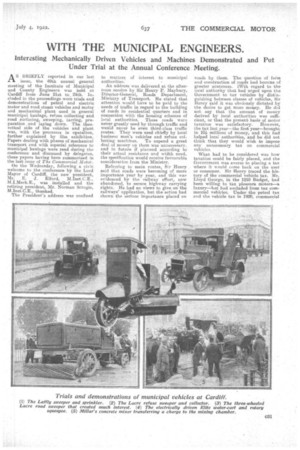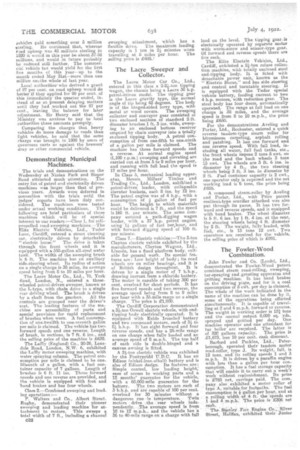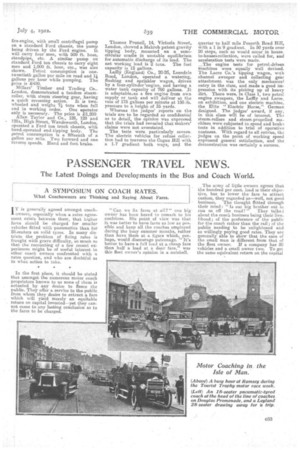WITH THE MUNICIPAL ENGINEERS.
Page 27

Page 28

Page 29

If you've noticed an error in this article please click here to report it so we can fix it.
Interesting Mechanically Driven Vehicles and Machines Demonstrated and Put Under Trial at the Annual Conference Meeting.
AS BRIEFLY reported in our last issue, the 49th annual general meeting of the Institute of Municipal and County Engineers was hekl at Cardiff from June 21st to 24th. Included in the proceedings were trials and demonstrations of petrol and electric motor and road steam vehicles and motor and mechanical plant used in general municipal haulage, refuse collecting and road surfacing, sweeping, tarring, preparation and laying down. The . theoretical side of the vehicles and plant was, with the processes in operation, further explained by film exhibition. Papers dealing with phases of mechanical transport and with especial. reference to municipal haulage were read during the conference and discussed by delegates, these papers having been summarized in the last.issue of The Commercial Motel%
On the Wednesday, following a civic welcome to the conference by the Lord Mayor of Cardiff, the new president, Mr. E. J. Elford, M.I.Mech.E., was installed and the retiring president., Mr. Norman Scrogie, M.Inst.C.E., thanked.
The President's address was confined to matters of interest to _municipal authorities..
An address was delivered at the afternoon session by Sir Henry P. Maybury, Director-General, Roads Department, Ministry of Transport. He stated that attention would have to be paid to the needs of traffic in regard to the building of roads in residential quarters and in connection with the housing schemes of local authorities. These roads were never greatly used by through traffic and would never be even third-class traffic routes. They were used chiefly by local business men's vehicles and refuse collecting machines. To expend a great deal of money on them was unnecessary. anrd in future if . planned according to their actual resistance and width need, the specification would receive favourable consideration from the Ministry.
Referring to main routes, Sir Henry said that roads were becoming of more importance year by year, and this was evidenced by the railway effort, now abandoned, to secure highway carrying rights. He had no views to give on the railways' application, but the action had shown the serious importance placed on
roads by them. The question of form and construction of roads had become of greater acuteness. iWth regard to the local authority that had urged upon the Government to tax vehicles by distin. guishing between classes of vehicles, Sir Henry said it was obviously dictated by the desire to get more money. He did not say that the amount of money derived by local authorities was sufficient, or that the present basis of motor taxation was satisfactory. However, the tax last year—the first year—brought in 104 millions of money, and this had helped local authorities, and he did not think that they would wish to impose any unnecessary tax on commercial vehicles.
What had to be considered was how taxation could be fairly placed, and the Government was averse to placing a tax where it. would come back on the user or consumer. Sir Henry traced the history of the commercial vehicle tax. Mr. Lloyd George, in the 1910 Budget, had been willing to tax pleasure motors—a luxury—bat had excluded from tax commercial vehicles. Under the petrol tax and the vehicle tax in 1920, commercial
webicles paid something over 5 million eterling. He continued that, whereas road upkeep was 45 millions sterling in 1920 it would in this year be about 37-38 millions, and would in future probably be reduced still further. The commercial vehicle tax would yield for the first five months of this year—up to the month ended May 31st—more than one million oni the whole of last year. .
Local authorities-who derived a grant of 97 per cent, on road upkeep would do better if they applied for 90 per cent, of this immediately the quarter ended, instead of as at present delaying matters until they had worked out the 97 per cent., leaving the balance for later adjustment. Sir Henry said that the Ministry was anxious to pay to local authorities these amounts promptly.
Comparing the charges that heavy vehicles do more damage to roads than light vehicles, he said that the same charge was brought in 1800 by users of governess carts as against, the brewers' dray or other commercial vehicle.
Demonstrating Municipal Machines.
The trials and demonstrations on the Wednesday at Ninian Park and Sloper Road attracted much attention. The entry list of petrol and electrically driven machines was larger than that of previous years. Awards were deferred in connection with the trials until the judges' reports have been duly con. sidered. rho machines were tested under actual working conditions. The following are brief particulars of those machines which will be of special interest to our readers :—Class 1, for self-propelled road sweeping machines.—The Elite Electric Vehicles, Ltd., Tudor Lane, Cardiff, entered a street cleaning car, electrically driven by detachable "electric horse." The drive is taken through the front wheels and it is equipped with a550-gallon all-steel water tank. The width of the sweeping brush is 6 ft. The machine has an auxiliary side-steering wheel. Its radius of action on a single charge is 38 miles, its average speed being from 8 to 10 miles per hour.
The Leese Motor Co., Ltd., 78, York Road, London N., entered a. threewheeled petrol-driven sweeper, known" as the L-type, with chain drive to a single rear driving wheel. The brush is driven by a shaft from tho gearbox. All the controls are grouped near the driver's seat. The leading features of the machine are accessibility of parts and special provision for rapid replacement of brushes when worn. A fuel consuriaption of one-twelfth to one-seventh gallon per mile is claimed. The vehicle has two forward speeds and one reverse. Length of brush, in sections, is 7 ft.. 6 ins., and the selling price of the machine is £638.
The Laffiy (England) Co., 20-26, Lensdale Road, London, N.W. 6, exhibited the Lafily motor sweeping machine, with water spraying column. The petrol consumption per mile is claimed to be onefifteenth of a gallon, with a fuel container capacity of 7 gallons. Length of brushes is 6 ft. 11 ins. Three forward speeds and one reverse are provided, and the vehicle is equipped with foot and 'hand brakes and has four wheels.
Class 2.—Combined sweeping and loading, operations;— F. Walters and Co., Albert Street. Rugby, demonstrated their pioneer sweeping and loading machine for attachment to motors. This sweeps a total width of 7 ft., including a channel
032 sweeping attachment, which has a flexible drive. The maximum loading capacity is 1 ton in 21 minutes when travelling at 5 miles per hour. The selling price is £485.:
The Lacre Sweeper and Collector.
The Lacre Motor Car Co.,Ltd., entered in this class a 2-2k-ton tipping wagon, the chassis being a Lacre 30 h-p. petrol-driven model. The tipping gear is the Lacre gravity type, the normal angle of tip being 42 degrees. The body is of the hinged-sided lorry type, with metal or wood covers. The sweeping collector and conveyor gear consisted of two enclosed sections of standard 2-ft. diameter brushes 1 ft. 3 ins. wide, sweeping to an enclosed bottom receiver emptied by chain conveyor into a totally enclosed tipping body. A petrol consumption of from one-fifth to one-ninth of a gallon per mile is claimed. The machine has three forward speeds and a reverse. At normal engine speed (1,100 r.p.m.) sweeping and elevating are carried out at from 5 to 9 miles per hour, and running with full load the speed is 12 miles per hour.
In Class 5, mechanical loading apparatus, Messrs. Millers' Timber and Trading Co., Ltd.. London, exhibited a petrol-driven loader, with collapsable elevator buckets, each 8 ins. by 12 ins. The petrol engine was of 4 lip. with a consumption of 41gallon of luel per hour. The height to which materials could be delivered is 7 ft., and the speed is 160 ft. per minute. The same company entered a path-digging wagon loader, with a 37 lip. petrol engine, using 14 gallons of fuel per,hour, and with forward digging speed of 100 ft. per minute.
Class 7.---Electric vehicles :—The 3-ton Clayton electric vehicle exhibited by the manufacturers, Clayton Wagons, Ltd., Lincoln, has a fixed platform body. suitable for general work. Its special features arc: Low height of body; its road wheels are on roller bearings, and it is of "British design throughout. It is driven by a single motor of 7 b.h.p., drawing current from a chloride battery. The motor is capable of taking 300 per cent, overload for short periods. It has five forward speeds and two reverse, the average speed" being from 8 to 9 miles per hour with a 35-mile range on a single charge. The price is £1.000.
The Cardiff Corporation demonstrated a 34-ton Orwell electric vehicle, with endtipping body electrically operated. It is equipped with Exide Ironclad battery and two compound motors, .each of 34 to b.h.p. it has eight forward and four reverse speeds, and has a 25-mile range on one charge when fully loaded and an average speed of 8 m.p.h. The top half of each side is double-hinged and a canvas awning is fitted.
A 24-ton electric vehicle was exhibited by the Pontypridd U.D.C. It has an Edison (nickel-iron-alkali) battery and is also of Edison design. Its features are: Simple control, low loading height; ease of access to working parts and a 12 months' guarantee for the vehicle, with a 60,000-mile guarantee for the battery. The two motors are _each of 3 b.h.p. and are capable of 100 per cent. overload for 30 . minutes without. a dangerous rise in temperature. Twin motors drive the . rear wheels independently. The average speed is from 10 to 12 m.p.h., and the vehicle has ia 36 to 40-mile range on a charge with full load on the level. The tipping gear,is electrically operated by separate motor with worm-screw and scissor-type gear. Of forward and reverse speeds there are five each.
The Elite Electric Vehicles, Ltd., Cardiff, exhibited a 24-ton refuse collection machine, with totally enclosed steel end-tipping body. It is fitted with detachable power unit, known as the " Electric Horse," and has side steering and control and turntable steering. It is equipped with the Tudor special vehicle battery, feeding current to two 4 h.p. motors, with reduction gear. The steel body has four doors, automatically operated. The range at full load on one charge is 38 miles, and the average speed is from 8 to 10 m.p.h., the price being £650.
For the demonstrations Aveling and Porter, Ltd., Rochester, entered a quick reverse tainlem-type steam roller for bituminous carpeting, asphalt rolling and patching. It has one forward and. one reverse speed. With full load, including all water, full fuel tanks, etc., the front wheels impose 2 tons 5 cwt. on the road and the back wheels 3 tons 15 cwt. The wheels are 3 ft. 6 ins. in diameter by 4 ft., the two steering wheels being 3 ft. 3 ins, in diameter by 2 ft. Fuel container capacity is 2 ewt., one operator only is required and the Oct working load is 6 tons, the price being £855.
A compound steam-roller by Aveling and Porter, Ltd., with -Price patent resilient-type scarifier attached was also put. through its paces. It has two forward and reverse speeds, and is equipped with band brakes. The wheel diameter is 5 ft. 6 ins. by 1 ft. 4 ins. at the rear, the steering wheels being 4 ft. diameter by 2 ft.. The weight, fully loaded, with fuel, etc., is 13 tons 12 cwt. Two operators are required for the vehicle, the selling price of which is £991.
The Fowler-Wood Combination.
John Fowler and Co. (Leeds), Ltd., demonstrated the Fowler-Wood patent combined steam road-rolling, sweeping, tar-spraying and grouting apparatus and gritting machine. It has band brakes on the driving plate, and for it a coal. consumption of 5 (nit. per day is claimed. The whole of the work indicated in the name of the machine can be done by it, some of the operations being effected simultaneously. It is capable of travelling at 2 and 4 m.p.h. forward or reverse. The weight in working order is 122 tons and the normal output 8,000 sq. yds. sprayed asnd gritted per day. One machine operator and one attendant for tar boiler are required. The latter is
of 320 gallons capacity. The price is £1,673, less 10 per cent. cash discount.
Barford and Perkins, Ltd.;' Peterborough, operated their tandem motor road-roller, type J. Its weight, full, is 12 tons, and its rolling speeds 1 and 5 m.p.h. It is driven by a paraffin engine with less than a gallon per hour consumption. It has a fuel storage capacity that will enable it to carry out a week's work without replenishment. Its price is £783 net, carriage paid. The company also exhibited a motor roller of type A, suitable for footpaths. The fuel consumption is 4 gallon.per hour, and at a Tolling. width of 4 ft. the -speeds are
land 4 The price -is £306 net Oath.
• The Stanley Fire Engine Co., Silver Street, Halifax, exhibited their Jiinior
fire-engine, with small centrifugal pump on a standard Ford chassis, the pump being driven by the Ford engine. It will carry four men, with 500 ft. hose, standpipe, etc. A similar pump on standard Ford ton chassis to carry eight
seen and 1,000 ft.. hose, etc., wasalso
shown. Petrol consumption is one. twentieth gallon per mile on road and gallons per hour while pumping. The price is £450. MilTars' Timber and Trading Co.. London, demonstrated a tandem steamroller, with steam steering gear, having a quick reversing action. It is twowheeled and weighs 7i tons when full and in working order. One operator only is necessary. The price is £1,200 Allan Taylor and Co., 126, 128 and 128a, High .&,reet, Wandsworth, London, operated a Ford ton truck chassis, with hand-operated end-tipping body. The petrol consumption is a fifteenth of a gallon per mile. Two forward and one reverse speeds. Hand and foot brake. Thomas Prunell, 14, Victoria Street, London, showed a Makrob patent gravity tipping body, mounted on a semicircular cradle in unstable equilibrium for automatic discharge of its load. The net working load is 2 tons. The fuei capacity is 12 gallons. Laffiy (England) Co., 20-26, Lonsdale Road, London, operated a watering, flushing and sprinkler wagon, driven by a four-cylinder 'engine, and having a water tank capacity of WA gallons. It is adaptable;as a fire engine from own supply or tank and will deliver at the rate of 175 gallons per minute at 150-lb. pressure to a height of 35 yards. Whereas the Judges' reports on the trials are to be regarded as confidential as to detail, the opinion was expressed. that the trials had revealed that makers' claims were not. overstated. The tests were particularly, severe. The electric vehicles for refuse collection had to traverse the Cogan Hill with 1-7 gradient both ways, and the quarter to half mile Penarth Road Hill, with a 1 in 9 gradient. In 50 yards over 20 stops, such as would occur in houseto-housescollection, were called for, and acceleration tests were made. The engine tests for petrol-driven machines were equally well devised. The Lacre Co.'s tipping wagon, with channel sweeper and collecting gear attachment was the only mechanical entry in the class, and made a good impression with its picking up of heavy dirt. There were, in Class 1, two petrol engine sweepers, the Laffiy and Lacre, on exhibition, and one electric machine, the Elite " Electric Horse," German designed. The judges' award, if any, in this class will be of interest. The steam-rollers and steam-propelled machines were subjected to speed and brake tests in addition to trial of operative neatness. With regard to all entries, the judges on the point of working speed expressed general satisfaction, and the demonstration was certainly a success.








































